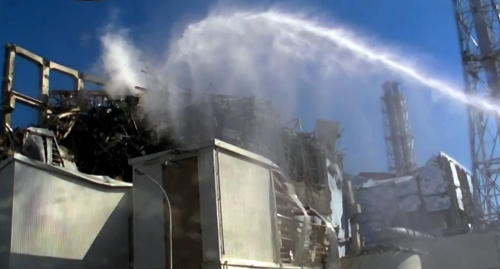Japan weighs entombing nuclear plant; IAEA sees criticality
By 이우영Published : March 31, 2011 - 15:44

Japan is considering pouring concrete into its crippled Fukushima atomic plant as the United Nation’s nuclear watchdog agency warned that a potential uncontrolled chain reaction could cause further radiation leaks.
Chief Cabinet Secretary Yukio Edano yesterday ruled out the possibility that the two undamaged reactors at Tokyo Electric Power Co.’s six-unit Dai-Ichi plant would be salvaged. Units 1 through 4 suffered from explosions, presumed meltdowns and corrosion from seawater sprayed on radioactive fuel rods after a March 11 earthquake and tsunami cut power to cooling systems.
Workers have averted the threat of a total meltdown by injecting water into the damaged reactors for the past two weeks. The complex’s six units are connected with the power grid and two are using temporary motor-driven pumps. Work to repair the plant’s monitoring and cooling systems has been hampered by discoveries of hazardous radioactive water.
The risk to workers might be greater than previously thought because melted fuel in the No. 1 reactor building may be causing isolated, uncontrolled nuclear chain reactions, Denis Flory, nuclear safety director for the UN’s International Atomic Energy Agency, said at a press conference in Vienna.
Localized criticality
Nuclear experts call these reactions "localized criticality," which will increase radiation and hamper the ability to shut down the plant. The reactions consist of a burst of heat, radiation and sometimes an "ethereal blue flash," according to the U.S. Energy Department’s Los Alamos National Laboratory web site. Twenty-one workers have been killed by "criticality accidents" in the past, the site said.
Radioactive chlorine found March 25 in the Unit 1 turbine building suggests chain reactions continued after the reactor shut down, physicist Ferenc Dalnoki-Veress of the James Martin Center for Nonproliferation Studies in Monterey, California, wrote in a March 28 paper. Radioactive chlorine has a half-life of 37 minutes, according to the report.
Tokyo Electric mixed boron, an element that absorbs neutrons and hinders nuclear fission, with emergency cooling water to prevent accidental chain reactions, Kathryn Higley, head of nuclear engineering and radiation health physics at Oregon State University in Corvallis, said in an e-mail.
Dismantling the plant and decontaminating the site may take 30 years and cost Tokyo Electric more than 1 trillion yen ($12 billion), engineers and analysts said. The government hasn’t ruled out pouring concrete over the whole facility as one way to shut it down, Edano said at a press conference.
Concrete solution
Dumping concrete on the plant would serve a second purpose: it would trap contaminated water, said Tony Roulstone, an atomic engineer who directs the University of Cambridge’s masters program in nuclear energy.
“They need to immobilize this water and they need something to soak it up,” he said. “You don’t want to create another hazard, but you need to get it away from the reactors.”
The process will take longer than the 12 years needed to decommission the Three Mile Island reactor in Pennsylvania following a partial meltdown in 1979, said Hironobu Unesaki, a nuclear engineering professor at Kyoto University.
Tokyo Electric’s shareholders may be wiped out by clean-up costs and liabilities stemming from the nuclear accident, the worst since Chernobyl. The company faces claims of as much as 11 trillion yen if the crisis lasts two years and potential takeover by the government, according to a March 29 Bank of America Merrill Lynch report.
(Bloomberg)
<한글 요약>
국제원자력기구(IAEA)는 일본 후쿠시마 원전에서 통제불능한 연쇄 반응이 일어나 더욱더 많은 방사능 유출이 야기될 수 있다고 경고함에 따라 일본은 이 원전을 콘크리트로 밀봉하는 방법을 검토하고 있다.
원전1-4호기는 지진 발생후 건물 폭발과, 노심용해로 추정되는 여러 현상들을 보였으며 이에 따라 방사성 물질 유출이 계속되어 왔다.
도쿄전력 직원들은 지난 2주간 지진으로 타격을 입은 원전에 해수를 부어 노심용해 현상을 방지하고자 노력해왔다.
<관련기사>
도쿄전력의 가쓰마타 쓰네히사 회장은 30일 방사성 물질 유출 사고를 낸 후쿠시마(福島) 제1원자력발전소 1∼4호기를 폐쇄하겠 다는 입장을 밝혔다.
가스마타 회장은 이날 오후 기자회견에서 "후쿠시마 제1원전 1∼4호기의 상황을 객관적으로 볼 때 폐쇄하지 않을 수 없다"고 말했다.
원전 사고를 낸데 대해서는 "건물의 폭발과 방사성 물질의 유출 등으로 여러분 에게 불안과 심려, 걱정을 끼친데 대해 사죄한다"고 말했다.
(연합뉴스)








![[Graphic News] More Koreans say they plan long-distance trips this year](http://res.heraldm.com/phpwas/restmb_idxmake.php?idx=644&simg=/content/image/2024/04/17/20240417050828_0.gif&u=)
![[KH Explains] Hyundai's full hybrid edge to pay off amid slow transition to pure EVs](http://res.heraldm.com/phpwas/restmb_idxmake.php?idx=644&simg=/content/image/2024/04/18/20240418050645_0.jpg&u=20240419100350)





![[From the Scene] Monks, Buddhists hail return of remains of Buddhas](http://res.heraldm.com/phpwas/restmb_idxmake.php?idx=652&simg=/content/image/2024/04/19/20240419050617_0.jpg&u=20240419175937)

![[KH Explains] Hyundai's full hybrid edge to pay off amid slow transition to pure EVs](http://res.heraldm.com/phpwas/restmb_idxmake.php?idx=652&simg=/content/image/2024/04/18/20240418050645_0.jpg&u=20240419100350)

![[Today’s K-pop] Illit drops debut single remix](http://res.heraldm.com/phpwas/restmb_idxmake.php?idx=642&simg=/content/image/2024/04/19/20240419050612_0.jpg&u=)